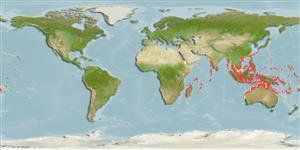>
Eupercaria/misc (Various families in series Eupercaria) >
Caesionidae (Fusiliers) > Caesioninae
Etymology: Caesio: Latin, caesius, bluish-grey, 1835; it is the same name given to the silvery metal (Cs) (Ref. 45335).
More on author: Seale.
Environment: milieu / climate zone / depth range / distribution range
Écologie
marin récifal; non migrateur; profondeur 5 - 60 m (Ref. 30874). Tropical; 30°N - 34°S, 28°E - 157°W (Ref. 402)
Indo-West Pacific: East Africa to the Line Islands. Not occurring in the Red Sea or the Arabian (Persian) Gulf.
Taille / Poids / Âge
Maturity: Lm ? range ? - ? cm
Max length : 40.0 cm TL mâle / non sexé; (Ref. 11228); common length : 26.6 cm SL mâle / non sexé; (Ref. 37816)
Épines dorsales (Total): 10; Rayons mous dorsaux (Total): 14-16; Épines anales 3; Rayons mous anaux: 12 - 13. This species is distinguished by the following characters: D X14-16, usually 15; A III,12-13, usually 12; pectoral-fin rays 18-23, usually 20-21; lateral line scales 51-61, usually 55; scales above lateral line to dorsal origin 7-10, modally 8, and below to anal-fin origin 16-20; predorsal scales 20-28; a single postmaxillary process; supratemporal band of scales interrupted at dorsal midline by a narrow scaleless zone; body colour blue with bright yellow on caudal fin, caudal peduncle, and body from just anterior to dorsal-fin origin to ventral origin of caudal peduncle, except in large individuals particularly in the western Pacific where the yellow does not extend as far anteriorly (Ref. 68703, 90102).
Adults are found primarily around coral reefs, with a preference for coralline lagoons. They feed on zooplankton in large midwater groups and form schools with other caesionids. Mature adults migrate to select areas around the reef to spawn near the surface in the entrances of deep channels during outgoing tides on a lunar cycle. They are oviparous, with numerous, small pelagic eggs (Ref. 402). Are caught with drive-in nets. Maximum depth reported taken from Ref. 128797.
Life cycle and mating behavior
Maturité | Reproduction | Frai | Œufs | Fécondité | Larves
Mass spawning of this species observed to occur only around sunset at or near full moon.
Carpenter, K.E., 1987. Revision of the Indo-Pacific fish family Caesionidae (Lutjanoidea), with descriptions of five new species. Indo-Pac. Fish. (15):56 p. (Ref. 1723)
Statut dans la liste rouge de l'IUCN (Ref. 130435)
Menace pour l'homme
Harmless
Utilisations par l'homme
Pêcheries: intérêt commercial mineur
Plus d'informations
RéférencesAquacultureProfil d'aquacultureSouchesGénétiqueElectrophoresesHéritabilitéPathologiesTraitementNutrientsMass conversion
CollaborateursImagesStamps, Coins Misc.SonsCiguateraVitesseType de nageSurface branchialeOtolithesCerveauxVision
Outils
Articles particuliers
Télécharger en XML
Sources Internet
Estimates based on models
Preferred temperature (Ref.
123201): 24.9 - 29.1, mean 28.2 °C (based on 988 cells).
Phylogenetic diversity index (Ref.
82804): PD
50 = 0.5020 [Uniqueness, from 0.5 = low to 2.0 = high].
Bayesian length-weight: a=0.01288 (0.00676 - 0.02456), b=3.12 (2.95 - 3.29), in cm total length, based on LWR estimates for this species & (Sub)family-body (Ref.
93245).
Niveau trophique (Ref.
69278): 3.4 ±0.45 se; based on food items.
Résilience (Ref.
120179): Haut, temps minimum de doublement de population inférieur à 15 mois (Preliminary K or Fecundity.).
Fishing Vulnerability (Ref.
59153): Low to moderate vulnerability (30 of 100).
Nutrients (Ref.
124155): Calcium = 53.2 [35.4, 76.6] mg/100g; Iron = 0.708 [0.466, 1.023] mg/100g; Protein = 19 [18, 20] %; Omega3 = 0.138 [0.096, 0.196] g/100g; Selenium = 33.1 [21.1, 55.5] μg/100g; VitaminA = 99.1 [41.3, 244.0] μg/100g; Zinc = 1.1 [0.8, 1.5] mg/100g (wet weight);
